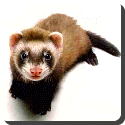 Ferret — In general use, a ferret is a domestic ferret (Mustela putorius furo). Domestic ferrets typically have brown, black, white, or mixed fur, have an average length of approximately 20 inches (51 cm) including a 5 inch (13 cm) tail, weigh about 2 pounds (1 kg), and have an ordinary lifespan of 7 to 10 years.
Ferret — In general use, a ferret is a domestic ferret (Mustela putorius furo). Domestic ferrets typically have brown, black, white, or mixed fur, have an average length of approximately 20 inches (51 cm) including a 5 inch (13 cm) tail, weigh about 2 pounds (1 kg), and have an ordinary lifespan of 7 to 10 years.
Several other small, elongated carnivorous mammals belonging to the family Mustelidae (weasels) also have the word “ferret” in their common names, including an endangered species, the Black-footed Ferret. The ferret is a very close relative of the polecat, but it is as yet unclear whether it is a domesticated form of the European Polecat, the Steppe Polecat, or some hybrid of the two.
The history of the ferret’s domestication is uncertain, like that of most other domestic animals. It is very likely that ferrets have been domesticated for at least 2,500 years, but it is not certain for what purpose the ferret was originally domesticated. It is known though that the Romans used ferrets for hunting rabbits. They are still used for that purpose in some parts of the world today, but increasingly they are being kept simply as pets.
Being so closely related to polecats, ferrets are quite easily able to hybridize with them, and this has occasionally resulted in feral colonies of ferret polecat hybrids that have been perceived to have caused damage to native fauna, perhaps most notably in New Zealand. As a result, some parts of the world have imposed restrictions on the keeping of ferrets.
Like most domestic animals, the original reason for ferret’s domestication by human beings is uncertain but it may have involved hunting. It was most likely domesticated from the European polecat (Mustela putorius), though it is also possible that ferrets are descendants of the Steppe polecat (Mustela eversmannii), or some hybridization thereof. Analysis of mitochondrial DNA suggests that ferrets were domesticated around 2,500 years ago, although what appear to be ferret remains have been dated to 1500 BC. It has been claimed that the ancient Egyptians were the first to domesticate ferrets, but as no mummified remains of a ferret have yet been found, or any hieroglyph of a ferret, that idea seems unlikely.
The ancient Greeks seem to have been familiar with ferrets. Ferrets, or at least ferret-like animals, are mentioned in a play written by Aristophanes, The Acharnians, in 425 BC. Whether this was actually a reference to ferrets or to polecats is uncertain, as the Greek word ictis is translated by some authorities as ferret and by others as polecat.
It is known that the Romans used ferrets for hunting rabbits. The name “ferret” is derived from the Latin furittus, meaning “little thief,” a likely reference to the common ferret penchant for secreting away small items.
Colonies of feral ferrets have established themselves in areas where there is no competition from similarly sized predators, such as in the Shetland Islands. Where ferrets coexist with polecats, hybridization is common. It has been claimed that New Zealand has the world’s largest feral population of ferret-polecat hybrids. In 1877, farmers in New Zealand demanded that ferrets be introduced into the country to control the rabbit population, which was also introduced by humans. Five ferrets were imported in 1879, and in 1882-1883, 32 shipments of ferrets were made from London, totaling 1,217 animals. Only 678 landed, and 198 were sent from Melbourne, Australia. On the voyage, the ferrets were mated with the European polecat, creating a number of hybrids that were capable of surviving in the wild. In 1884 and 1886, close to 4,000 ferrets and ferret hybrids, 3,099 weasels and 137 stoats were turned loose. Concern was raised that these animals would eventually prey on indigenous wildlife once rabbit populations dropped, and this is exactly what happened to New Zealand bird species which previously had no mammalian predators.
Ferrets are obligate carnivores and the natural diet of their wild ancestors consisted of whole small prey, i.e., meat, organs, bones, skin, feathers, and fur. Some ferret owners feed a meat-based diet consisting of whole prey like mice and rabbits along with raw meat like chicken, beef, veal, kangaroo and wallaby. This is preferred in Europe and Australia, and becoming increasingly popular in the United States due to concern over high carbohydrate levels in some processed ferret foods.
Alternatively, there are many commercial ferret food products. Some kitten foods can also be used, so long as they provide the high protein and fat content required by the ferret’s metabolism. Most adult cat foods and kitten foods are unsuitable for ferrets however, because of their low protein content and high fiber. Ideally, a ferret food should contain a minimum of 32% meat based protein and 18% fat. Low-quality pet foods often contain grain-based proteins, which ferrets cannot properly digest.
Ferrets may have a fondness for sweets like raisins, bananas, peanut butter, and pieces of cereal. The high sugar content of such treats has been linked to ferret insulinoma and other diseases. Veterinarians recommend not feeding raisins and the like to ferrets at all. Also, like many other carnivores, ferrets gradually lose the ability to digest lactose after they are weaned. As a result, lactose-free milk is to be preferred.
 Kids Portal For Parents India Kids Network
Kids Portal For Parents India Kids Network






